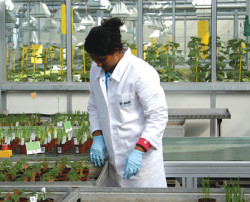Headline News

However, there are still positive stories to tell in the crop protection business. Take BASF, for example. In September, the Limburgerhof, Germany-based company gathered members of the media at its headquarters to report the results of its 2007 sales year, and the news was far from bleak. For the year, BASF crop protection sales increased from 2006, from $2.621 billion to $2.624 billion. Even more promising, said Michael Heinz, president of the agricultural products division, BASF believes this upward trend will continue as overall agricultural market conditions improve.
“Agriculture around the world has accelerated in recent months,” said Heinz. “More and more farmland is needed to grow crops for energy conversion. Prices for some of the most important agricultural products have risen sharply. This in turn has increased the readiness of growers to invest in crop protection products.”
No Short-Term Trend
“We don’t see this development as a flash in the pan, but rather as the start of a long-term trend,” he continued. “We thus expect demand for innovative crop protection products to move onto a higher plateau amid continuing higher prices for farm products.”
Of course, the primary sales driver for BASF was the fungicide segment of the business, lead by the success of F500, sold under the tradename Headline in the U.S. BASF fungicide sales increased 10% in 2007, from $965 million to $1.06 billion. In particular, Heinz credited the acceptance of Headline for this growth.
This market success could just be beginning, added Heinz. BASF already has an agreement in place with the Monsanto Co. under which Monsanto’s distribution employees are recommending the use of Headline to U.S. customers for their corn and soybean seed stocks. “This makes us a clear trend-setter,” he said. “We offer the growers an innovative technology, which is fast gaining acceptance with the increasing use of corn and soybeans for the production of biofuels.”
Hopes In The Pipeline
For BASF’s other two crop protection segments — herbicides and insecticides — the news wasn’t as bright. In 2007, herbicide sales dropped 10% to $1.03 billion. Insecticide sales, meanwhile, grew only slightly, up 3% to $535 million. In both instances, said Heinz, the move to seeds with weed and insect resistant traits hurt product sales.
But rather than be discouraged by the performance of these two segments in 2007, Heinz told attendees that BASF is anticipating better news ahead, particularly as the company launches several new active ingredients currently under development in its product pipeline.
“We are currently working on seven new active ingredients and on a new herbicide tolerance project,” he said. “We successfully introduced the corn herbicide topramezone to the market last year. This year, we are working to introduce our rice fungicide orysastrobin in Japan.”
For the U.S. market, he added, the next big herbicide development from the company could be ready for the 2009/10 growing season. The product will address one of the biggest issues currently facing growers — how to deal with an increasing number of resistant weed species. “Principally in the U.S., weeds are increasingly developing resistance to the universally applied active ingredient glyphosate, and this has now taken on proportions affecting the market,” said Heinz.
BASF’s answer is a product codenamed BAS 800H, which uses what Heinz described as a “unique mode of action” to control troublesome weeds. “BAS 800H has outstanding activity against broadleaf weeds when it comes in direct contact with leaves or through the pretreated soil,” said Heinz. “It can be broadly applied and also combats those problem-causing weeds against which the available alternatives have proven ineffective.”
Heinz said that BASF is planning to submit the proper registration papers to U.S., Canadian, and Australian authorities for BAS 800H in January.






